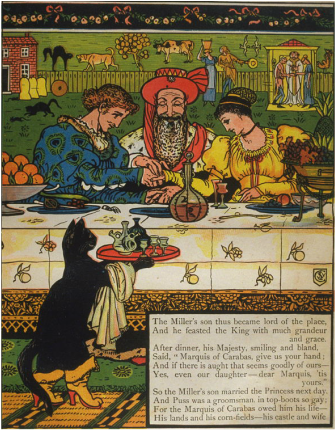|
Perrault's "Puss in Boots" begins with a poor miller's son, alone in the world except for a pet cat. Things look bleak, until the cat speaks up. It has a plan to put the boy on a path straight up the social ladder, turning him from a beggar to the future king.
This is accomplished by a whole lot of lying. When the cat first introduces his master to the king and his daughter, he dubs him the Marquis of Carabas. The name is mentioned again and again throughout the story, and becomes the moniker by which the character is always referred. We never learn his real name. So what is Carabas? It's likely just a nonsense word created by Perrault. The cat makes up a title out of whole-cloth and gradually adds a princess and a castle to back it up. Carabas is not a real place. It's not supposed to be. In The Great Fairy Tale Tradition, Jack Zipes suggests that Perrault could have taken inspiration from stories of a fool in Alexandria named Carabas, who people mocked by treating like a king, or the Turkish word "Carabag" for a summer vacation spot in the mountains. A carabas is also a French term for a cage-like carriage, but the earliest mention I find of it is from 1874, well after Perrault, and it may derive from the Puss in Boots story. There are a few similar words in French. "Car" is a dialect word from Picardy meaning something along the lines of "that's why." "Caraba" is cashew nut oil. However, like the previous examples, these words have no obvious connection to Perrault's story. There are many versions of this tale, and some include similar aliases. A Swedish version has the Princess of Cattenburg, which is clearly Cat Town. Similarly, there's the Earl of Cattenborough in Joseph Jacobs' European Fairy Tales. It's unclear where exactly Jacobs got this story. The characters' names (Charles, Sam, and John) are all very English. He may have drawn elements from different variants of the Puss tale. He specifically mentions the Princess of Cattenburg, so he may have gotten the name here. Italian versions are Don Joseph Pear (derived from the pear tree that he owns) and Count Piro (which I believe also derives from pears in the story). Other Italian versions have the cat or fox helper rename its master Caglioso or Gagliuso, a name meaning youth. Actually, in quite a few of these versions, the animal helper is female. Perrault made the character male. Sometimes it's explained as a magical cat or an enchanted princess, but Perrault's cat just happens to be able to talk. SOURCES
Text copyright © Writing in Margins, All Rights Reserved
1 Comment
Jenny
5/15/2020 12:35:57 am
the year is 2020, i am a sane adult and I actually google-searched "where is carabas" ... and this is where the search took me. Yes, you are allowed to laugh. i can see that i am going to love this site. thank you in advance. peace!
Reply
Leave a Reply. |
About
Researching folktales and fairies, with a focus on common tale types. Archives
July 2024
Categories
All
|
Writing in Margins

 RSS Feed
RSS Feed
